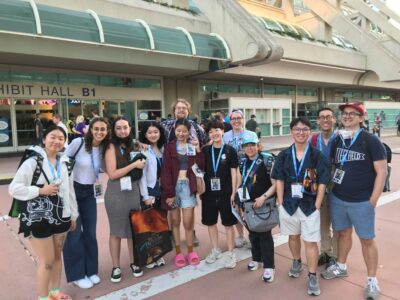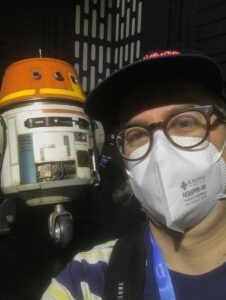Dr. Felan Parker is a Professor in the Book & Media Studies program specializing in digital media, video games, and media industries. His current research explores the production, distribution, and reception of independent or “indie” games, and the role of fan conventions like San Diego Comic-Con in contemporary popular media cultures.
University of Toronto Quarterly recently published Prof. Parker’s review of The Far Shore: Indie Games, Superbrothers, and the Making of Jett, as part of their big “Letters in Canada 2021” omnibus issue.
San Diego Comic-Con (SDCC) is not just any comic con, it’s the Comic-Con – with a copyrighted hyphen to prove it. Although fan conventions celebrating popular media like comics, games, film, and television can be found in all corners of the world, SDCC occupies a privileged place. Over the course of its 50+ year history, SDCC has become a key venue for both grassroots fan community and large-scale media industry promotion, driven by much-vaunted claims of exclusivity: exclusive collectibles, exclusive previews, exclusive celebrity appearances, and exclusive access (approximately 130,000 people attend each year, many more wish they could). The convention takes place over five days in July and offers something for practically everyone: panels and workshops large and small, cosplay (dressing up as pop culture characters), signings, a massive exhibition hall full of retail booths, screenings, gaming, interactive promotional activations, portfolio reviews for aspiring creators, and a lot of walking around and waiting in line.
SDCC has been the subject of extensive academic research; it offers a unique site to investigate the relationship between audiences and media industries, and the intermediaries (including SDCC itself) that shape those relationships. This is a rich body of work, but the daunting scale and scope of SDCC means that every attendee has a different experience, and it is impossible for one researcher to apprehend the event in its totality. My colleague Benjamin Woo (Carleton University) and I decided to try something different: what if we studied SDCC with a large, coordinated team of researchers?

Inspired by previous methodological experiments in “swarm ethnography” and “collaborative event ethnography,” we assembled an all-star team of fandom and media industry scholars, graduate students, and undergrad students from the Book & Media Studies program. The goal of this project, dubbed Swarming San Diego Comic-Con, was to better understand the role of SDCC in contemporary popular culture by conducting up-close and personal ethnographic research from a wide variety of different perspectives, simultaneously. We successfully applied for a SSHRC Insight Grant to support a research trip to SDCC, originally scheduled for 2021 but ultimately delayed until 2023 by the ongoing pandemic.
After a crash course in ethnographic research methods and a test run at the much smaller, less mainstream Toronto Comic Arts Festival, we set out for San Diego with our six intrepid undergrad researchers in tow. Even after reading extensively about SDCC and hearing from more seasoned con-going members of the team, nothing can prepare you for its overwhelming magnitude and dizzying range of activities demanding your attention. For Shurui Wu, the research trip allowed her to combine her life-long fandom with her academic interests – disembarking the trolley in front of the San Diego Convention Centre for the first time and seeing the massive crowds of fellow fans was a “dream come true.”

Over the course of SDCC, the “undergrad squad” (as they dubbed themselves) had many unique and exciting experiences. Along with several other members of the team, Esmé Sanders was delighted to have the opportunity to see Japanese horror comics master Junji Ito in the flesh. “Lining up for 2+ hours and getting front-row seats was rewarding and made me feel like I got the full Comic-Con experience. I enjoyed watching Junji Ito draw live. It’s a privilege to see the behind-the-scenes process of some of your favourite art!” Jae Kim and Brian Tin shared their own similar experience of getting up before the crack of dawn and joining a huge line to score an exclusive Star Wars Tamagotchi toy featuring Grogu, AKA Baby Yoda.
Indeed, lining up is a big part of attending SDCC, and the lines not only build anticipation but also are important space for community-building. Jae Kim found the environment more friendly than he imagined, highlighting the important social aspect of the convention that is easily overshadowed by the flashy Hollywood promotion and consumerism. “Starting up conversations with people in lines, by the entrance, and even in washrooms came to me like second nature. In a way, it reminded me that we were all at SDCC because we were all fans, which was a nice sentiment to have amidst the chaos.” Likewise, Debi Jin was thrilled to happen up on an autograph signing session with Makoto Yukimura, creator of the popular manga and anime Vinland Saga. Although the signing was only for people who registered in advance, she joined a small group of fans looking on. “As I looked at the faces of those in our little group, however, it seemed to me that we were all just happy to be in Makoto Yukimura’s presence. After he signed the last lucky fan’s merchandise, we all clapped and slowly went our separate ways.” The experience of seeing beloved creators in the flesh is enhanced by the communal atmosphere of the con.
Students also observed that the demographics of SDCC were not what they expected based on their experiences in fan cultures, which are often unwelcoming spaces for women, people of colour, queer folks, and other groups marginalized on the basis of identity. “Before going, I expected a hyper-masculine space filled with sweaty (and sometimes smelly) fans (myself included),” Brian recalls. “But the diversity of con-goers, in terms of age, gender, race, really pleasantly surprised me (and the venue smelled reasonably fine).” Nevertheless, there remain many issues around inclusivity and access. Esmé noted that while there were many fans with disabilities in attendance, accessibility accommodations were lacking: “it still seemed like a hectic place to navigate with an assistive device. It underscored the need for even more comprehensive accessibility measures at events like these.”
Although SDCC 2023 was billed as a return to form after several years of online and smaller-scale cons, the announcement of strike actions by the Writers Guild of America and later the Screen Actors Guild-American Federation of Television and Radio Artists against the Alliance of Motion Picture and Television Producers made labour issues in Hollywood and beyond a unexpectedly central area of interest for the project. Would SDCC be diminished by the lack of big Hollywood stars promoting their work? Or would it be a return to an imagined grassroots past before Hollywood took over? Even though she would have liked to see celebrities, Shurui wasn’t too disappointed, because there was still plenty of exciting content from other sectors of the global entertainment industries. “I was surprised by how many Japanese companies where there, and the scale of their booth and activations. This made me finally understand how influential Japanese [media] industry is.”
The focus on labour issues also raised questions about how fans are compelled to participate in marketing and promotion. “One moment I found particularly striking was when fans were lining up to advertise (post) on social media pictures of the Hello Kitty x MetaZoo booth for a chance to win a gift basket,” Esmé says, echoing fan studies discourses on fandom as a form of unpaid labour. “It felt like a lot of physical labour and free advertisement.”
The research trip concluded with a debriefing and brainstorming session with the whole team at UC San Diego, where students compared notes, shared insights, posited initial observations, and raised unanswered questions that will help guide our research as we move into the data analysis and knowledge mobilization phases of the project. These invaluable contributions from Book & Media Studies students will help shape our understanding of San Diego Comic-Con and its place at the intersection of popular media industries and fan cultures.
Read other InsightOut posts
